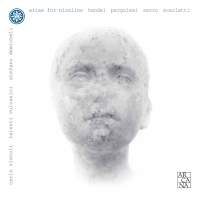Texte paru dans: / Appeared in: |
|
|
Outil de traduction ~ (Très approximatif) |
|
|
Reviewer: Bertil
van Boer
Continuing a trend that
focuses on performers rather than composers, this disc explores works
written for castrato Nicola Grimaldi (1673–1732), also known as Nicolino.
Trained in Naples in the Conservatorio della Pietà dei Turchini, his vocal
skill even as a young boy was enough to debut at 12 years old. Following the
operation, his voice matured downwards towards the mezzo range, but he
maintained his stature as a leading singer due both to its dexterity and
deep expressive quality. It also did not hurt that he was apparently a
consummate actor, able to portray a variety of operatic characters with
considerable emotion and realism. His early association with Alessandro
Scarlatti also helped to some degree, but by 1700 he had outgrown Naples and
began a career elsewhere, eventually arriving in London in 1708. By 1712 he
had become acquainted with Handel, performing in Rinaldo, one of the
composer’s greatest successes. For much of the rest of his life he
apparently traveled back and forth to Italy, and his success and fame, never
quite on the level of Farinelli, nonetheless won him many fans even as he
aged. Of course, his roles in the opera seria of the time were legion, but
this disc attempts to give some examples, performed by countertenor Carlo
Vistoli with a small Baroque period instrument ensemble, the Talenti
Vulcanici.
First off, I am not entirely
convinced of using various instrumental bits from the operas in a disc
devoted to a single singer’s legacy. It’s not that the performances lack
talent. Indeed, the rather feisty Prelude to Rinaldo is short enough not to
disturb at the beginning, but when the entire overture is performed later
on, it seems a bit of overkill, as does the inclusion of the instrumental
sinfonia from Amadigi. Both are done with a cautious style that is perfectly
nice though not revelatory. Indeed, there is more than a bit of musical
similarity in the slow openings, very French with extensive double dotted
rhythms, and the contrapuntal faster sections that seem to wander as is
Handel’s wont. The Sarro overture, on the other hand, seems more Italian in
its opening fanfares and unisons that call the audience to order. His short
30-second second movement evokes Vivaldi in the dotted rhythms that lead
directly into a rather stark triple meter dance movement that was more than
a little modern in the late Baroque style. As for the arias, they are
show-stoppers. In the Sarro first example from Arsace, the agitation and
tortuous coloratura demonstrate a good grasp of the opera seria solo aria
form. This is a sort of “Take that, Farinelli” in terms of difficulty, but
it is short, perhaps because it is an expostulation rather than a tour de
force. The two Pergolesi arias from Salustia are at the dawn of the
Classical style, with the first a lyrical content interrupted by some
definitive unisons. It is clear here that the range indicates Nicolino was
getting on in years, since the tessitura is hardly as expansive as in the
Handel examples. The second aria, “Per trucidar,” is typical as an agitato
with a bit of recitative inserted into the stormy main section. Again, the
tessitura is not great, with Pergolesi writing for someone whose voice is
not still in its prime but that can still wield much dramatic expression. Of
the Handel arias, the “Cara sposa” from Rinaldo stands out as gentle,
soaring, and quite dramatic, with its opening mezza di voce and gently
mournful lyrical line. It is a tour de force that requires great stamina,
not for the pyrotechnics but rather for the need for constant emotional
display. Countertenor Vistoli does a nice job in recreating Nicolino’s dramatic style. He doesn’t force his tone or his lyricism, and as a result the voice contains some particularly moving emotion. I am less impressed by the Talenti Vulcanici, which I find a bit inconsistent. The violins in particular are scratchy at times in their upper registers, but the two oboes know how to give their lines nice nuances. The tempos seem a bit staid at times, though in rapid passages, such as that of “Cara sposa,” the brief outbursts have considerable energy. Given that most of this is already available elsewhere for complete recordings, I would suggest that this disc will be of interest to those who wish to compare the music that the composers of that age wrote for particular castrati. For that reason alone it would be worthwhile acquiring. | |
|
Support us financially by purchasing this disc from eiher one of these suppliers. Un achat via l'un ou l'autre des fournisseurs proposés contribue à défrayer les coûts d'exploitation de ce site. |
|
|
|
|
|
Cliquez l'un ou l'autre
bouton pour découvrir bien d'autres critiques de CD |
|




